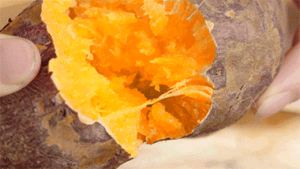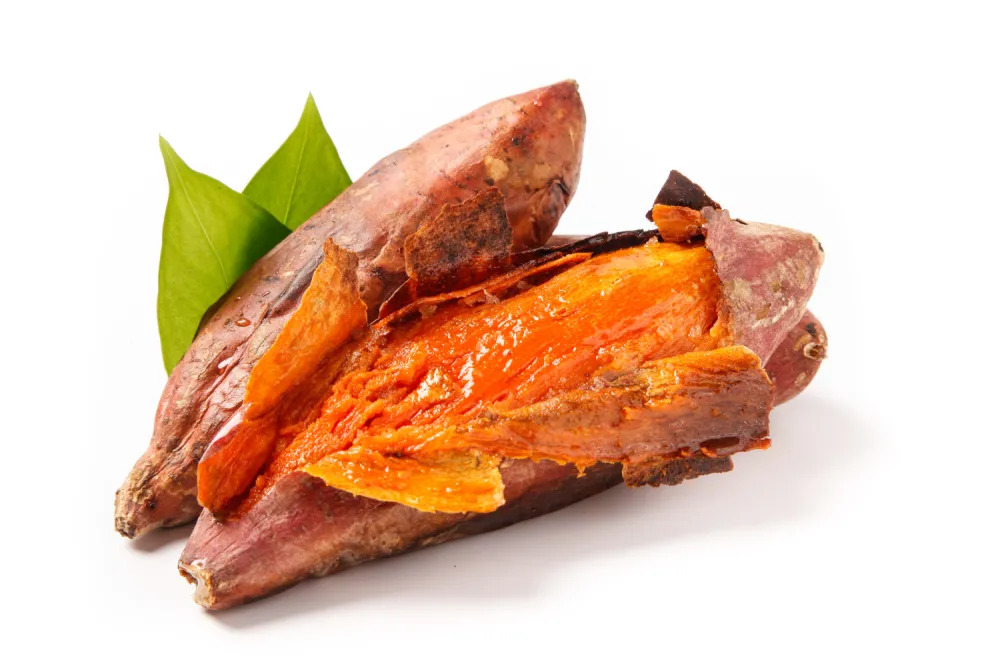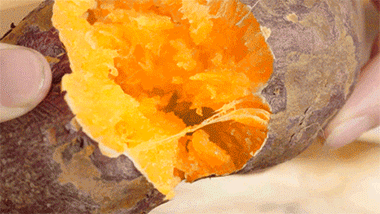
Finally, the best time to eat baked sweet potato has come.
In cold days, nothing makes people feel more fortunate than holding hot and delicious baked sweet potatoes in their hands.
I want to make it at home, but the sweet potatoes cooked at home or baked in the microwave oven are always not as sweet as those baked in the big coal oven on the side of the road.
“Why is the baked sweet potato sold in the street stall more delicious?”
The delicious of baked sweet potato mainly lies in its sweetness. The warming characteristics of the baking process can bring more sweetness.
In fact, raw sweet potato is not particularly sweet, but high temperature heating will activate amylase in sweet potato and decompose starch, the main component of sweet potato, into sweet sugars such as maltose and glucose.
The activity of this enzyme is the highest at 50 ~ 70 ℃. The longer the heated sweet potato stays in this temperature range, the more starch decomposed by amylase and the sweeter the sweet potato.
Baked sweet potato just meets this condition: Although the temperature is generally set at 200 ℃, when heating from room temperature, due to the slow heat conduction of air, the internal temperature of sweet potato rises slowly and stays longer within the appropriate temperature range of amylase.
The temperature of boiled sweet potato increased rapidly and the total heating time was short; Microwave heated sweet potato heats up rapidly, and amylase loses its activity before it can fully play its role. In short, the maltose produced by both methods is less than that produced by baking, and it doesn’t taste so sweet.

In addition to sweetness, the aroma and color of baked sweet potato are also very attractive. This is mainly related to long-term high-temperature baking.
When the temperature exceeds the melting point, some sugars in sweet potato (especially on the surface of sweet potato) will undergo dehydration and degradation, produce caramel flavor and other flavors, and darken the surface color of sweet potato, which is caramelization reaction.
At the same time, high temperature will promote the Maillard reaction (browning reaction) between a small amount of protein contained in sweet potato and maltose, and also produce flavor substances and dark substances, adding pleasant aroma and attractive color to baked sweet potato.
Usually, the sweet potatoes on the street are baked slowly at high temperature in the stove, which gives the two reactions enough temperature (at least 140 ℃) and time, with more natural aroma and better color.
It’s no wonder that we can smell the aroma of roasted sweet potato from a distance. When we walk over and look at the golden color, our saliva can’t stop.
“But even if you understand these principles, it’s hard to make that special flavor by yourself…”
Yes, the hardest thing to remember is the happiness that will overflow when you eat steaming sweet potatoes in the cold wind.
Why does the baked sweet potato on the street have better taste?
Finally, the best time to eat baked sweet potato has come.
In cold days, nothing makes people feel more fortunate than holding hot and delicious baked sweet potatoes in their hands.
I want to make it at home, but the sweet potatoes cooked at home or baked in the microwave oven are always not as sweet as those baked in the big coal oven on the side of the road.
“Why is the baked sweet potato sold in the street stall more delicious?”
The delicious of baked sweet potato mainly lies in its sweetness. The warming characteristics of the baking process can bring more sweetness.
In fact, raw sweet potato is not particularly sweet, but high temperature heating will activate amylase in sweet potato and decompose starch, the main component of sweet potato, into sweet sugars such as maltose and glucose.
The activity of this enzyme is the highest at 50 ~ 70 ℃. The longer the heated sweet potato stays in this temperature range, the more starch decomposed by amylase and the sweeter the sweet potato.
Baked sweet potato just meets this condition: Although the temperature is generally set at 200 ℃, when heating from room temperature, due to the slow heat conduction of air, the internal temperature of sweet potato rises slowly and stays longer within the appropriate temperature range of amylase.
The temperature of boiled sweet potato increased rapidly and the total heating time was short; Microwave heated sweet potato heats up rapidly, and amylase loses its activity before it can fully play its role. In short, the maltose produced by both methods is less than that produced by baking, and it doesn’t taste so sweet.

In addition to sweetness, the aroma and color of baked sweet potato are also very attractive. This is mainly related to long-term high-temperature baking.
When the temperature exceeds the melting point, some sugars in sweet potato (especially on the surface of sweet potato) will undergo dehydration and degradation, produce caramel flavor and other flavors, and darken the surface color of sweet potato, which is caramelization reaction.
At the same time, high temperature will promote the Maillard reaction (browning reaction) between a small amount of protein contained in sweet potato and maltose, and also produce flavor substances and dark substances, adding pleasant aroma and attractive color to baked sweet potato.
Usually, the sweet potatoes on the street are baked slowly at high temperature in the stove, which gives the two reactions enough temperature (at least 140 ℃) and time, with more natural aroma and better color.
It’s no wonder that we can smell the aroma of roasted sweet potato from a distance. When we walk over and look at the golden color, our saliva can’t stop.
“But even if you understand these principles, it’s hard to make that special flavor by yourself…”
Yes, the hardest thing to remember is the happiness that will overflow when you eat steaming sweet potatoes in the cold wind.
Comments